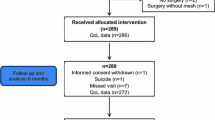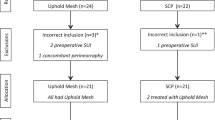Abstract
Introduction and hypothesis
To examine changes in sexual function after abdominal and transvaginal pelvic organ prolapse repair.
Methods
Women enrolled in our prospective, longitudinal prolapse database with abdominal sacrocolpopexy (ASC) or transvaginal (TVR) pelvic organ prolapse (POP) repair with or without mesh, between 19 December 2008 through 4 June 2014. The Pelvic Organ Prolapse/Urinary Incontinence Sexual Questionnaire (PISQ-12) and the Pelvic Floor Distress Inventory (PFDI -20) were mailed preoperatively, and at 6 and 12 months postoperatively. Patients completed Global Response Assessments to rate their overall satisfaction.
Results
Two hundred and four of the 300 women met the inclusion criteria: 74 out of 204 (36 %) had ASC and 130 out of 204 (64 %) had TVR. Seventy-two out of seventy-four ASCs were performed robotically and 2 were open. Baseline demographics were similar except that the ASC patients were significantly younger (60 vs 63, P = 0.019) and had a higher rate of apical repair (77 % vs 55 %). Thirty-six out of seventy-four ASC (48.7 %) and 63 out of 128 TVR patients (49.2 %) were sexually active at baseline (P = 0.94). Sixteen out of thirty-eight ASC (42.1 %) and 18 out 63 TVR patients (28.6 %; P = 0.16) reported dyspareunia at baseline. Seventy-two out of seventy-four ASC (97 %) and 86 out of 130 TVR patients (66 %) had mesh-augmented repairs. There was no difference in sexual activity or dyspareunia between the groups at the 6- or 12-month follow-up. PISQ and PFDI scores improved significantly in both the ASC and TVR groups over time compared with the baseline (p < 0.0001). Most women in the ASC (77.5 %) and TVR (64.8 %) groups were satisfied with the results of prolapse surgery at 12 months.
Conclusions
Sexual function and pelvic floor symptoms improved in a similar manner in patients after abdominal and transvaginal POP surgery.
Similar content being viewed by others
References
El Haddad R, Svabik K, Masata J, Koleska T, Hubka P, Martan A (2013) Women’s quality of life and sexual function after transvaginal anterior repair with mesh insertion. Eur J Obstet Gynecol Reprod Biol 167(1):110–113
Kim SR, Moon YJ, Kim SK, Bai SW (2014) Changes in sexual function and comparison of questionnaires following surgery for pelvic organ prolapse. Yonsei Med J 55(1):170–177
Abdel-Fattah M, Familusi A, Fielding S, Ford J, Bhattacharya S (2011) Primary and repeat surgical treatment for female pelvic organ prolapse and incontinence in parous women in the UK: a register linkage study. BMJ Open 1(2), e000206
Siddiqui NY, Fulton RG, Kuchibhatla M, Wu JM (2012) Sexual function after vaginal versus nonvaginal prolapse surgery. Female Pelvic Med Reconstr Surg 18(4):239–242
Jia X, Glazener C, Mowatt G et al (2008) Efficacy and safety of using mesh or grafts in surgery for anterior and/or posterior vaginal wall prolapse: systematic review and meta-analysis. BJOG 115(11):1350–1361
Nieminen K, Hiltunen R, Takala T et al (2010) Outcomes after anterior vaginal wall repair with mesh: a randomized, controlled trial with a 3 year follow-up. Am J Obstet Gynecol 203(3):235.e1–235.e8
Weber MA, Lakeman MM, Laan E, Roovers JP (2014) The effects of vaginal prolapse surgery using synthetic mesh on vaginal wall sensibility, vaginal vasocongestion, and sexual function: a prospective single-center study. J Sex Med 11(7):1848–1855
Burrows LJ, Meyn LA, Walters MD, Weber AM (2004) Pelvic symptoms in women with pelvic organ prolapse. Obstet Gynecol 104(5 Pt 1):982–988
Liang CC, Lo TS, Tseng LH, Lin YH, Lin YJ, Chang SD (2012) Sexual function in women following transvaginal mesh procedures for the treatment of pelvic organ prolapse. Int Urogynecol J 23(10):1455–1460
Altman D, Elmer C, Kiilholma P, Kinne I, Tegerstedt G, Falconer C (2009) Sexual dysfunction after trocar-guided transvaginal mesh repair of pelvic organ prolapse. Obstet Gynecol 113(1):127–133
Celik DB, Kizilkaya Beji N, Yalcin O (2014) Sexual function in women after urinary incontinence and/or pelvic organ prolapse surgery. J Clin Nurs 23(17–18):2637–2648
Bartuzi A, Futyma K, Kulik-Rechberger B, Skorupski P, Rechberger T (2012) Transvaginal Prolift(®) mesh surgery due to advanced pelvic organ prolapse does not impair female sexual function: a prospective study. Eur J Obstet Gynecol Reprod Biol 165(2):295–298
Sentilhes L, Berthier A, Sergent F, Verspyck E, Descamps P, Marpeau L (2008) Sexual function in women before and after transvaginal mesh repair for pelvic organ prolapse. Int Urogynecol J Pelvic Floor Dysfunct 19(6):763–772
Azar M, Noohi S, Radfar S, Radfar MH (2008) Sexual function in women after surgery for pelvic organ prolapse. Int Urogynecol J Pelvic Floor Dysfunct 19(1):53–57
Milani AL, Hinoul P, Gauld JM, Sikirica V, van Drie D, Cosson M (2011) Trocar-guided mesh repair of vaginal prolapse using partially absorbable mesh: 1 year outcomes. Am J Obstet Gynecol 204(1):74.e1–74.e8
Salamon CG, Lewis CM, Priestley J, Culligan PJ (2014) Sexual function before and 1 year after laparoscopic sacrocolpopexy. Female Pelvic Med Reconstr Surg 20(1):44–47
De Tayrac R, Devoldere G, Renaudie J et al (2007) Prolapse repair by vaginal route using a new protected low-weight polypropylene mesh: 1-year functional and anatomical outcome in a prospective multicentre study. Int Urogynecol J Pelvic Floor Dysfunct 18(3):251–256
Rogers RG, Coates KW, Kammerer-Doak D, Khalsa S, Qualls C (2003) A short form of the pelvic organ prolapse/urinary incontinence sexual questionnaire (PISQ-12). Int Urogynecol J Pelvic Floor Dysfunct 14(3):164–168, discussion 168
Barber MD, Walters MD, Bump RC (2005) Short forms of two condition-specific quality-of-life questionnaires for women with pelvic floor disorders (PFDI-20 and PFIQ-7). Am J Obstet Gynecol 193(1):103–113
Pauls RN, Segal JL, Silva WA, Kleeman SD, Karram MM (2006) Sexual function in patients presenting to a urogynecology practice. Int Urogynecol J Pelvic Floor Dysfunct 17(6):576–580
Jha S, Gray T (2015) A systematic review and meta-analysis of the impact of native tissue repair for pelvic organ prolapse on sexual function. Int Urogynecol J 26(3):321–327
Ulrich D, Dwyer P, Rosamilia A, Lim Y, Lee J (2015) The effect of vaginal pelvic organ prolapse surgery on sexual function. Neurourol Urodyn 34(4):316–321
Mamik MM, Rogers RG, Qualls CR, Morrow JD (2014) The minimum important difference for the pelvic organ prolapse-urinary incontinence sexual function questionnaire. Int Urogynecol J 25(10):1321–1326
Panman CM, Wiegersma M, Talsma MN et al (2014) Sexual function in older women with pelvic floor symptoms: a cross-sectional study in general practice. Br J Gen Pract 64(620):e144–e150
Knoepp LR, Shippey SH, Chen CC, Cundiff GW, Derogatis LR, Handa VL (2010) Sexual complaints, pelvic floor symptoms, and sexual distress in women over forty. J Sex Med 7(11):3675–3682
Maher C, Feiner B, Baessler K, Schmid C (2013) Surgical management of pelvic organ prolapse in women. Cochrane Database Syst Rev 4: CD004014.
Alperin M, Ellison R, Meyn L, Frankman E, Zyczynski HM (2013) Two-year outcomes after vaginal prolapse reconstruction with mesh pelvic floor repair system. Female Pelvic Med Reconstr Surg 19(2):72–78
Conflicts of interest
Larry Sirls is a consultant for Johnson and Johnson and research investigator for American Medical Systems and Cook. Priyanka Gupta, James Payne, Kim Killinger, Michael Ehlert, Jamie Bartley, Jason Gilleran, Judy Boura have no conflicts to disclose.
Source of funding
Ministrelli Program for Urology Research and Education (MPURE-Philanthropy)
Author information
Authors and Affiliations
Corresponding author
Rights and permissions
About this article
Cite this article
Gupta, P., Payne, J., Killinger, K.A. et al. Analysis of changes in sexual function in women undergoing pelvic organ prolapse repair with abdominal or vaginal approaches. Int Urogynecol J 27, 1919–1924 (2016). https://doi.org/10.1007/s00192-016-3066-9
Received:
Accepted:
Published:
Issue Date:
DOI: https://doi.org/10.1007/s00192-016-3066-9




